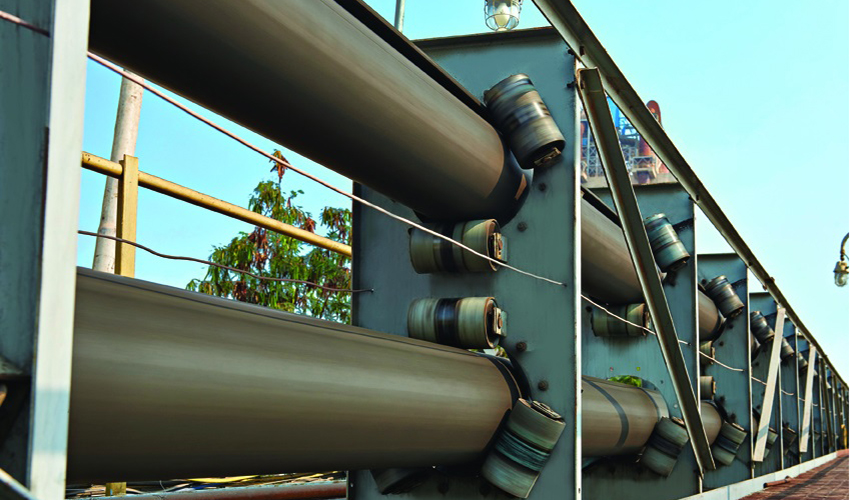The structure of the head, tail, receiving point (including multi-point receiving), tensioning device, etc. of the
tubular belt conveyor is exactly the same as that of the conventional
belt conveyor, and there is no difference.
The round pipe feed is formed only after the loading point of the conveyor to the middle conveying section before the discharge point. That is, after the tail receiving section, the tape gradually transitions from the parallel to the trough deep groove (this distance is very short), and finally the material is wrapped and rolled into a circular tube: in the forming section, the tape is forcibly wrapped by a hexagonal roller. In a round tube, the conveyed material is enclosed in the round tube and runs stably with the replacement. When it reaches the head (or the central discharge point), the transition is gradually changed, the shape of the round tube becomes deeper, the trough shape is finally in the head roller (or the central discharge section becomes parallel and unloading. The return section of the tape is also substantially the same as the load-bearing section, and is generally formed into a tubular shape, but the tape can also be returned in a parallel or V-shape in the return section.

1.1 Drive Unit
The selection method of the driving device of the belt belt machine is exactly the same as that of the conventional
belt conveyor driving device. It can be selected according to the driving combination on the "DTII Belt Conveyor Selection Manual".
1.2 Conveyor Idler
The
belt idler mainly has a hexagonal idler set, a trough-shaped transitional idler set and an arc-correcting idler set. The trough-shaped transitional idler set is used for the transition section between the head and the tail, and its structure and arrangement spacing As with the conventional belt conveyor, 10°, 20°, 30°, 45°, and 60° can be selected according to the length of the transition section. The arrangement pitch of the hexagonal roller set is related to the diameter of the pipe of the pipe belt machine. The selection method is shown in the table. The correction roller is mainly used for the horizontal bending section and the vertical bending section of the belt belt machine. The selection method is in the case where the number of hexagonal rollers is constant, in the curved section, every other set of hexagons The roller selects a set of correcting rollers (that is, the number of rollers in the curved section is twice that of the straight section). The shape of the belt roller is the same as that of the ordinary roller, but its waterproof performance and rotational resistance coefficient are better. Ordinary roller.
1.3 Conveyor Belt
The equipment adopts a special conveyor belt for the belt belt machine. According to the requirements of different tension and other conditions, the conveying can be in the form of a nylon fabric core layer and a steel cord core. The tape used in the belt machine mainly includes: nylon, polyester fabric core and steel cord core tape.
When the tape of the tape machine is laid flat, it is indistinguishable from the shape of the ordinary tape. However, in order to ensure the sealing and stability of the tape after the pipe is formed, the tape is required to have the following characteristics: a) The tape should have appropriate bending rigidity, and the rubber should be mainly adjusted. The formulation and thickness as well as the adjustment of the canvas across the edge of the tape for good tubular retention and sealing. b) The flexibility and fatigue resistance of the tape are required to ensure that its service life meets and exceeds the normal conveyor belt.
The choice of conveying specification and core form should take into account factors such as the maximum tension value of the conveyor belt, the conveying distance, the conditions of use and the safety factor.
1.4 Trusses and Brackets
In order to install the belt roller bracket (ie truss), the belt belt machine generally adopts the frame (ie truss) in the form of Figure 1. The support is made of a garden-shaped bracket. Since the belt truss has sufficient rigidity, it can be on both sides. A sidewalk and access road are added to replace the conveyor trestle. If the belt machine is arranged along the ground or has a trestle, there is no need to select the truss and bracket. This is one of the reasons why the belt machine saves the cost.
1.5 Other Parts
The structure of the drive roller, the reversing roller, the tensioning device, the headstock tailstock, the guide trough, the funnel, the tail shroud, the head sweeper, the empty section cleaner and the like are completely identical to the structure of the ordinary
belt conveyor.





